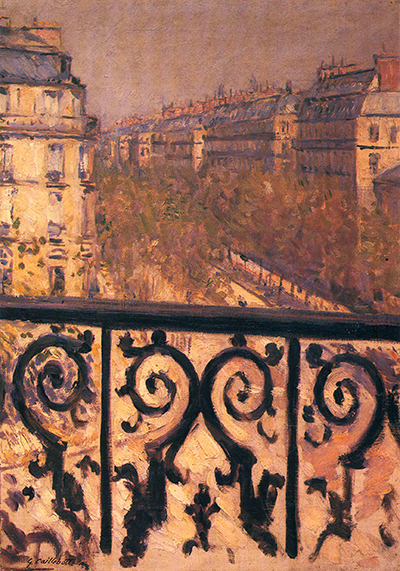Gustave painted this piece from a balcony in Paris. The then Emperor and baron had embarked on a project to renew the town of Paris into an urbanised city. Impressionist painters loved showcasing this part of the new Paris on their canvases, and Gustave was one such painter. In this painting, the balcony is the subject hence, the use of cast-iron curls that form decorative patterns, which fill the entire picturesque. The viewer is also able to make out the Boulevard Haussmann from a distance where there is an advertising column, passers-by and a carriage. Gustave lived down the street hence, his enthusiasm to paint what was happening to Paris when Baron was renovating it.
Style
Gustave used dark colours to bring out the centrality of the railing on the balcony. The dull colours also create a sharp contrast against the backdrop that features a street scene made of pastel hues. He adds a bold composition that is inspired by Japanese prints and crops the painting abruptly using solid colours and high vantage points that echoed a modern style. Critics argued that Caillebotte’s use of dark and bright colours contradicted the Impressionist style and was Realist. This is because he never relied on photographs and drawings to base his artwork as other painters.
Inspiration
Apart from Gustave’s apparent interest in the development made by the Emperor, the motif may have been inspired by juxtapositions that are evident in many Japanese ukiyo-e prints. The technique advocated for the use of sharp and bright colours and often delineated contours using Sumi ink similar to linework in prints.
Related Paintings
Paris Street: Rainy Day
Gustave’s painted this piece in 1877 to illustrate the vast cobblestone street that stretched in front of the wedge-shaped buildings. He creates this piece during the winter season hence, the men and women in long skirts with dark umbrellas. Unlike other Impressionists who seemed to moan the effects of Industrialisation in Paris and its surrounding, Gustave had a positive outlook. In his paintings, he included men standing on balconies or leaning on a new bridge to counter the belief that modern life did not create close relations between human beings. This painting remains one of the best pieces and has been in the collection of the Art Institute of Chicago. It has been displayed during the 19th Century French painting exhibition in Washington DC.




